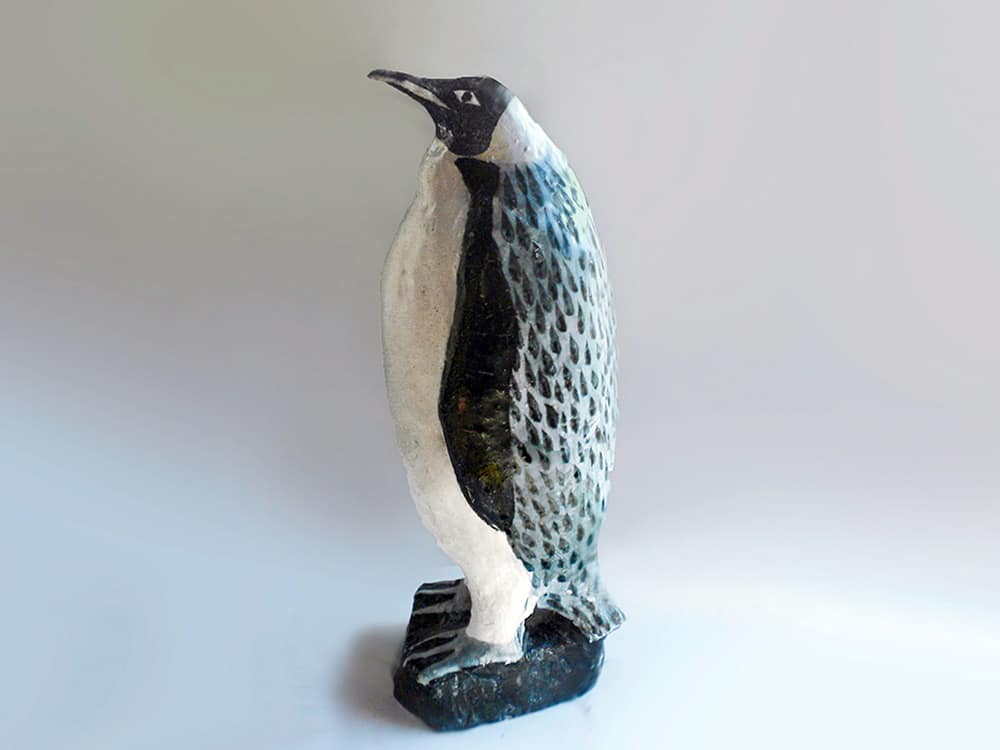
The signature on a ceramic work identifies the author, but the true signature is in the hand of the artist, which is as unique as handwriting. This one-of-a-kind vintage Emperor Penguin was created when the decoration for the production design was under development. The overall uniformity of the pattern is one of the keys to identifying that the penguin is decorated by Weston and not by Brenda.


Weston’s hand is patient, disciplined, and rhythmic. The pattern is systematic but not mechanically uniform. Weston takes a philosopher’s approach to pattern. The components of the pattern are integral to an inseparable expression of wholeness. The state of mind is at one with the beingness of existence. Weston patiently executes the teardrops in an organically flowing rhythm on the backside of the Emperor Penguin.
A similar approach to pattern is shown in the vase, by Weston. The parts are irregular dabs in an organically organized formation, which produces an overall effect that appears deceptively regular, like life

Weston’s approach might be compared to that of the drummer. Brenda’s approach to pattern is as a narrative. Brenda is the dancer who lays a linear storyline over the background of the beat, one might say, a beatnik pattern maker, as the artist’s culture was called in her day.
Brenda is the creator of the tree pattern. Trees all tell a story of life, responsive to the rain, wind, sun, moon, and stars, causing their branches to reach out in a way unique to each tree. The philosopher focuses on beingness, while the narrator tells the events of an individual journey through time

My own childhood artwork can be identified by the wreaths I placed around the characters. This is how I envisioned the world in my first philosophical conceptualization, as I sat, at the age of five, in the midst of an unmowed grassy field, most likely the first summer that we lived in Maine. I thought about myself as a circle, and my family as a larger circle, and the other people in the world as an even larger circle. The whole world was the largest circle, but it could blow itself up. That didn’t make sense and ruined the whole concept I had going in my head.

If the figure in the center looks dismayed, that is why. That’s my generation, the first generation born into a world that could blow itself up. We had to practice hiding under our desks, but we knew it was much worse than that. Other generations have since been born into the same world, but the way of dealing with it changed, and children in the sub-primary class no longer have to practice hiding under desks, preparing for an atomic bomb attack. Now they have to prepare for other kinds of attacks coming from their most immediate circle.
My narration went off pattern, when I leaped from the immediate to the far, The atom, or that non-thing that we call atoms, takes a quantum leap when it goes from one orbit to the next. It doesn’t happen in conventionalized time and space. Within the nucleus, within the nucleu,s within the nucleus, there is only consciousness.
That takes us deep into the process of creation, the essence of what makes us human. The process of creating a pattern is a process of consciousness. Creating a pattern is a state of being, like chopping wood and carrying water, and dancing around the room to the beat because there is no one to stop you from doing so in your own studio, and why small studios are in the Andersen Design master plan.

The eyes of the Emperor Penguin repeat the teardrops in stark black and white. Gray claws grip the base like a pronouncement of creaturehood. The sculpture has the mildly rough surface of a freshly sculpted piece cast in its first mold, and the beat goes on.










